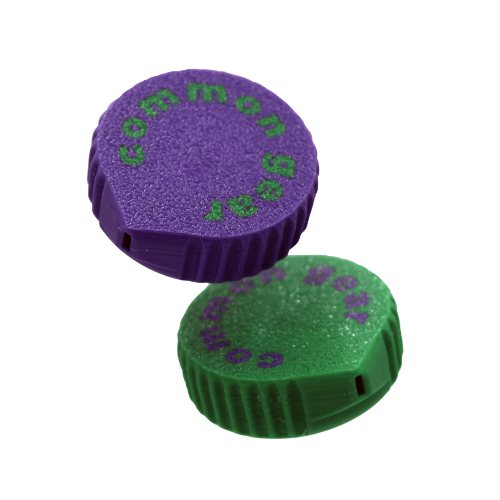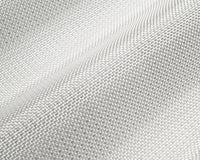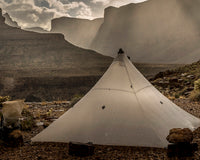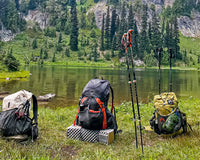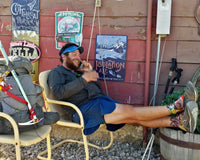
Ray Aldridge, the creative behind ultralight brand common gear, has been hiking in the Sierra Nevada Mountains well before he was even born. His parents met on a Sierra Club backpacking trip, which his mother frequently led. From hiking in the womb, in a child carrier and finally walking on his own, Ray was destined to continue in their footsteps.
When his thirst for hiking ultralight collided with his formal education in materials engineering, common gear was born.
“I am a big gram counter,” Ray laughed. After a torn ACL in high school, he had to be sensitive of his knees on longer hikes, and thus tried to keep his pack weight to a minimum.

In order to achieve an 8 or 9 pound base weight, Ray resorted to creating many of his own items, like the Bottle Cap & Tether.
This durable, ultralight bottle cap secures to the bottle itself and is compatible with water bottles commonly sold on trail like Smart Water and Life Water. “The first ones were haphazard, but over time, I made my dream bottle cap.”
While a “dream bottle cap” may seem futile, it served a real utility for Ray. “The main benefit is it secures it to the bottle so you can’t lose it. I once lost my water bottle cap on trail, and while it seems like a minor thing, it’s incredibly inconvenient!” he laughed. “And it’s easier to open the bottle when wearing gloves, too.”

“At that point, I had put 100 hours of engineering into this bottle cap that only I, and maybe four friends, are going to use,” Ray laughed. “So I poured another 100 hours into it and made it a real product!”
“From there, I realized if I’m going to sell one product, I might as well solve all the problems that I see in my backpacking gear and make those solutions available to everyone.”
Introducing: common gear.
“I looked at items that take me out of the moment,” Ray explained. “The whole goal is to create gear that fades into the background, that allows you to be more present and lets nature take center stage.”
After studying at UC Santa Cruz and later acquiring a degree in Materials Engineering from Bells Engineering in Minnesota, Ray learned a thing or three about the better, lighter, stronger and more adaptable materials that make up the world. In addition to polymers, he knows heaps about compostable items. But, it doesn’t take an engineering degree to know that toilet paper is not going to compost in many areas that we’re backpacking.

“It’s great that people are getting outdoors, but the more hikers we have, the more we’re seeing toilet paper hidden behind trees off trail. And there’s a misconception that it will break down.”
Committed to Leave No Trace principles, Ray engineered the 3 Gram Bidet as a way to eliminate the use of toilet paper in the backcountry, or at least greatly reduce it.
“The main thing leading to poor degradation of human waste is the lack of water, so by using a bidet when backpacking, you increase the water content of that area where you’ve left something behind, and speed up its degradation.”
After several late nights making the bidet smaller and lighter, shaving off 100ths of a gram, Ray got it down to 3 grams. “I think it’s as light as it could ever get,” he laughed. The universal fit easily secures onto any standard 28mm water bottle (again, like Smart Water or Life Water) commonly seen on trail. By packaging the bidets in two-packs, Ray hopes using a bidet on trail becomes less taboo and more normalized.

Next came the UL Gravity Filter Hang System, one of common gear’s more abstract ideas. “While there have been ultralight bidets and bottle caps before, this is the first hang system for gravity filters to my knowledge.”
Ray finds himself doing a fair amount of backpacking during the shoulder season, and often runs into cold and wet weather. “When I scoop up water and my hands get cold and numb, it’s hard to take that gravity filter and hang it on a branch.”
The ultralight hanging system allows the user to hang a filter using just a single hand, and that hand can be gloved. “It really lives up to that brand goal of not making the gear take center stage, but allowing the hiker to be more present and not tie knots with numb hands.”
Next up was perfecting the ideal first aid kit for backpackers. As Ray found out, many on the market look great as a flat lay, but for any UL hiker, quality is more important over quantity. “So I went out and purchased the Maserati of Band-Aids,” he laughed, “the best of every item, and nothing in excess.”
At 59 grams, the common gear First Aid Kit includes products hikers love like ultralight Repair Kit components, plenty of tapes and patches, and practical first aid supplies. According to Ray, it has everything you need and not too much more. A new iteration of the First Aid Kit will launch later this year to include an even lighter ECOPAK carrying pouch made by Harford Gear Co., a fellow Garage Grown Gear partner.

All common gear products, down to the packaging, are made by Ray himself out of his San Francisco, CA home. “Everything is made in America with materials that are well vetted from American suppliers, and not supporting any questionable manufacturer overseas,” he added. “I’m a big believer in making things here and reducing that carbon footprint. I’ve done everything I can, and paid the premiums, to keep everything domestic.”
As the Bay Area where Ray resides is bursting with innovations like autonomous cars and social media platforms, the novelties brought to fruition by common gear may seem like a very small outlier. “I just feel great to be creating products that allow people to be more in the moment and also help reduce waste on the trail. These are products that I enjoy using and are the ultimate inspiration behind everything I sell."
“Even if you don’t count grams, these products serve a role in providing reliable, redundant, sustainable and ethically produced gear.”
Ray is quick to acknowledge the support he’s received from fellow cottage brands in the ultralight space. “It’s incredible. Everyone is so collaborative. We’re all working toward making cool, useful items, and everyone is always thinking about sustainability and impact. It’s a very value-driven community, and I’m privileged to be a part of it.”

Originally from Alaska, Maria currently resides in Montana with her husband, two young daughters and chocolate lab named Echo. When she’s not chasing her kids or that next running goal, you can find her weekend-warrioring in the mountains or thinking about her next cup of coffee.





